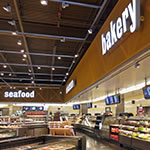This past spring, Strack & Van Til’s newest location in Cedar Lake, Indiana, received LEED Silver certification, the first such distinction the company has received. For the supermarket chain, it represents the culmination of a company-wide effort to reduce its energy spending by adapting green and sustainable design-build practices while enhancing the shopping experience for its customers.
“Our primary reason for seeking LEED certification on this project was that the new energy code made the gap between LEED certification and complying with the energy code much closer,” says John Ritchie, director of facilities for Strack & Van Til. “We felt that the additional cost to build a LEED-certified store would be worth it.”
A former Wilco store, the existing building proved too small, and the walls and roof were cast-in-place concrete with virtually no insulation. Strack & Van Til, also a licensed general contractor and acting as such on this project, decided to demolish it and rebuild, grinding the rubble and using it as fill material on site.

(This photo and all others) LED lighting is controlled via daylight sensors, and open-deck refrigerator cases are outfitted with glass doors or night curtains to reduce unnecessary waste.


Building new from the ground up also allowed Strack & Van Til to fully optimize daylighting through skylights and windows around the perimeter that allow natural light to fill the interior. “When you introduce daylighting, you have a lower ambient, and by using LED lighting instead of florescent, you create a more comfortable shopping experience,” Ritchie says. Additional lighting controls allow for the maintenance of lighting levels throughout the store. Lighting levels are increased or decreased according to the availability of natural light. Light levels, therefore, remain constant and create a more comfortable, customer-friendly environment as well as a more efficient building that further reduces energy costs.
Grocery stores use a great deal of refrigerant, but at the Cedar Lake store, open-deck refrigerator cases are outfitted with glass doors or night curtains to reduce unnecessary waste. Those refrigerated cases can have as many as 12 fans a piece, and the new store features energy-efficient models. Further optimizing the company’s refrigerator management system, computer software monitors the use of refrigerant to meet or surpass EPA standards and manage costs.
Over time, many building systems tend to lose their calibration and begin consuming additional energy, so Strack & Van Til regularly recommissions its stores. All equipment is checked and tested to ensure that it is fully operating to manufacturers’ specifications. A company-wide measurement and verification program is in place, and, in addition to commonplace recycling practices such as those associated with cardboard and cooking oil, Strack & Van Til has supported its sustainable practices by participating in programs offered by utility providers, partnering with them in pilot programs designed to reduce energy usage.
“This has been a learning effort for us,” Ritchie says. “We’re always trying to reduce our energy spend, and part of LEED certification has to do with the environment, the shopping experience. We wanted to make sure that we achieved that by building the most efficient building possible and provide the best environment as possible, in terms of the shopping experience.”

